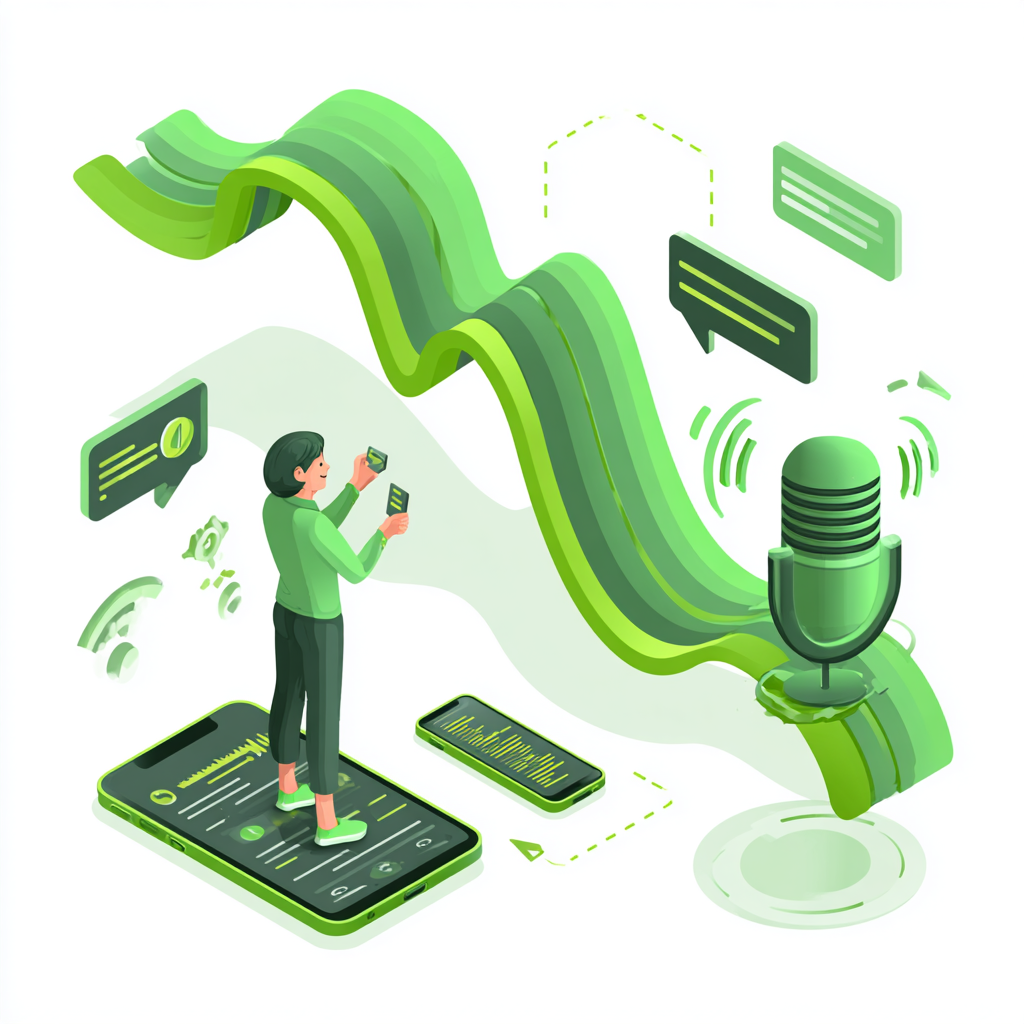Learning how to send voice SMS can transform your client outreach. Reaching out to your customers and audience personally can improve your message’s reception.
Voice SMS offers a compelling way to achieve this by delivering recorded audio messages directly to your recipients. This approach ensures your message reaches them in their preferred language, making your communication more engaging and memorable.
Unlike traditional text messages, voice SMS allows you to send a recorded voice message directly to someone’s phone. Whether you’re sharing offers, updates, or personal greetings, Voice SMS provides a unique way to stand out and deepen your connection with your audience.
Step-by-step guide on how to send a voice SMS
Sending a voice SMS is a powerful way to deliver your message with a personal touch. Follow this detailed guide to ensure your voice SMS is sent effectively and reaches your audience in the most impactful way. Here’s a step-by-step guide on how to send a voice SMS effectively.
Choose the right platform
Selecting the right platform is crucial for the success of your voice SMS campaign. Each platform has different features, so knowing what they offer and where they fall short will help you decide wisely.
Several mobile carriers and messaging apps offer voice SMS functionality. Popular options include:
- Carrier services: Many mobile network providers offer voice SMS services as part of their standard offerings. These services are often accessible, requiring just a phone call to record and send your message.
- Messaging apps: Messaging apps like WhatsApp, Facebook Messenger, and Telegram provide a more user-friendly approach to sending voice messages.
- Dedicated voice SMS services: Specialized services like Voxygen or CallHub are designed for more advanced voice SMS needs, particularly for businesses.
- MessageBird dashboard: The MessageBird dashboard provides a customizable platform ideal for businesses seeking advanced voice SMS capabilities.
Prepare your voice message
Before recording your voice message, careful planning is key to ensuring your message is compelling and well-received. Here are some tips to help you prepare:
- Be brief: Aim to keep your message short, ideally between 20 and 30 seconds. Being brief helps maintain the listener’s attention and ensures your message is concise.
- Speak clearly: Clarity is essential when recording voice messages. Pronounce your words clearly and speak steadily to ensure all listeners understand the message quickly, regardless of familiarity with your voice or language.
- Avoid background noise: The environment in which you record your message can greatly impact its quality. Find a quiet place with minimal background noise, such as one with no traffic, conversations, or electronic devices. Even subtle noises can distract from your message and reduce its effectiveness.
- Practice your message: Practice what you plan to say before hitting the record button. This can help you identify any potential issues with wording or pacing and allow you to adjust your delivery for maximum impact.
- Stay focused on the audience: Customize your message to your audience’s needs and preferences. Consider the language, tone, and style that resonate most with your recipients. A well-targeted message is more likely to be received positively and to achieve the desired response.
Record your voice SMS
The recording process may vary depending on the platform you choose. Here’s a general guide:
Using carrier services:
- Dial the voice SMS number. Your carrier may provide a specific number for sending voice SMS. Dial this number from your phone.
- Follow instructions: You should listen to some prompts before recording. Follow the instructions to record your message.
- Send your message: After recording, follow the prompts to send your voice SMS to the desired recipient.
Using messaging apps:
- Open the app: Launch the messaging app where you want to send the voice SMS.
- Select the contact: Choose the recipient from your contact list or enter their phone number.
- Record the message:
- iPhones: Open the Messages app, tap the apps button, then tap Audio to start recording. Tap the stop button to finish recording. To send the message, tap the Send button. If you want to listen to it first, tap the Play button. To save the message, tap Keep within 2 minutes after sending or listening. To always keep audio messages, go to Settings > Messages > Expire, then tap Never.
- Android phones: Open the Messages app, press the microphone icon next to the text input field, speak your message, and release to stop recording. Press the send button to deliver the message.
- Playback and deletion: iPhones: Tap the play button to listen to the message. To delete it, press and hold the message, select “More,” and tap the trash icon. Android phones: You can listen to the message by tapping the play button. To delete, press and hold the message, then select the trash icon or delete option.
Using dedicated voice SMS services:
- Sign up: Create an account with the voice SMS service provider.
- Upload your voice file: Some services require uploading a pre-recorded voice file. Use your phone or computer to record and save the file before uploading.
- Enter recipient details: Input the recipient’s phone number and any additional information required.
- Send the message: Confirm and send your voice SMS per the service’s instructions.
Using the MessageBird dashboard:
- Create the message:
- Go to the MessageBird dashboard and click on Voice → Send Voice Message.
- Select languages and voice preferences (male/female) and enter your message. You can also choose to repeat the message if necessary.
- Use templates for recurring messages and personalize by setting up variables for recipient-specific details.
- Originator and recipients:
- Select an originator (caller ID) from a MessageBird number.
- Add recipients manually, from your phonebook, or in groups. You can enter up to 300 numbers manually.
- Verify and schedule: Review your message for accuracy and check settings. Schedule the message, setting the date, time, and frequency if needed.
Verify delivery
After sending your voice SMS, it is essential to confirm that it was successfully delivered:
- Carrier services: Check with your carrier if they offer delivery reports or confirmations.
- Messaging apps: Most apps show a status indicator when a message is sent and received.
- Dedicated services: Many voice SMS platforms provide delivery reports or logs that you can review.
- MessageBird dashboard: Verify delivery through the dashboard’s reporting features, if available.
Troubleshooting tips
If you encounter issues while sending a voice SMS, consider the following:
- Check network connection: Ensure your internet or mobile connection is stable.
- Verify service availability: Confirm the voice SMS service is operational and compatible with your device.
- Review settings: Ensure your phone or app allows for voice recording and messaging.
Understanding platform differences
There are some differences in how voice SMS (or voice messages) are used on iPhones and Android phones due to variations in operating systems and default apps:
iPhones:
- Using iMessage: Open the Messages app, tap the Apps button, then tap Audio to record your message. You can listen, send, or save the message as needed. Messages are automatically deleted after 2 minutes unless saved.
- Carrier services: iPhones use visual voicemail, which differs from voice SMS but serves a similar purpose for recorded messages.
Android phones:
- Using Google Messages: Open the Messages app, keep your finger on the microphone icon to record your message, then release and send. Playback and deletion are managed similarly.
- Carrier services: Some Android devices have carrier-specific apps or services for sending voice SMS, which can vary by carrier. While the core functionality of sending and receiving voice messages is similar, the user experience can differ due to operating system design and app-specific features.
Maximizing your voice SMS experience
Sending a voice SMS is straightforward and adds a personal touch to your communications. By choosing the right platform, preparing your message, recording it clearly, and verifying delivery, you can ensure your voice SMS is effective and well-received.
Mastering this communication tool can enhance your interaction with others and convey your messages more effectively, whether for personal or business purposes. Platforms like MessageBird can further streamline the process, offering advanced features for personalization and scheduling that are especially useful for business communications.
The Messages app provides iPhone users with a built-in solution for sending and managing audio messages, including options for saving and transcribing messages.





